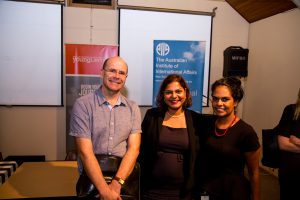Indigenous Treaty Recognition - an international perspective
On a warm and thundery night, AIIA NSW partnered NSW Young Lawyers in a discussion on Indigenous Treaty Recognition at Glover Cottages on Tuesday 21 March.
The event was chaired by Nicole D’Souza, head of the NSW Young Lawyers Human Rights Committee. Speakers were George Williams AO, Anthony Mason and Scientia Professor at UNSW Law, Teela Reid, former Indigenous Youth delegate to the UN Permanent Forum on Indigenous Issues, and Clark Donovan, a Gumbaynggirr and Gunditjmara man from Campbelltown, now in his penultimate year of degrees in Law and Languages at UTS, Sydney.
George opened with a definition of an Indigenous Treaty – an agreement between federal and State governments on the one hand and indigenous nations on the other, in other words, between the colonised and the colonisers. Issues requiring resolution in such a document include who owns what land, who controls communities, dispossession and compensation, and the use and application of Aboriginal names.
George observed that Canada, the United States and New Zealand have such treaties, Australia does not. To begin with, participants negotiating a treaty here would have to acknowledge that land was taken, and that indigenous languages and culture are legitimate. On this basis, real outcomes could be achieved only through negotiation between equals – not by governments deciding what’s best. Resisting the concept, former Prime Minister John Howard once said that a nation does not have a treaty with itself. But that’s precisely what the Canadians, Americans and Kiwis have. Australia is unique among dispossessing nations in not recognising shared sovereignty. But treaties are being negotiated in Western Australia, South Australia and Victoria.
Teela Reid observed that part of the present difficulty was that many Aboriginal nations have lost their own sense of cultural identity. How can one negotiate with such fractured groups? Clark added that it was very difficult to engage with a lot of nations when each sees itself as sovereign. A blanket approach won’t work.
George said every group must define itself before negotiating. In Canada it took twenty years to work out the basis of negotiation. The vicious cycle of confrontation must be avoided. The term ‘treaty’ seems to scare Australians. It becomes a toxic narrative. An educative process is needed.

From l to r: George Williams, Nicole D’Souza and Teela Reid
Nicole asked what international law says about indigenous treaties. George observed that International Law recognises that indigenes have rights to self-determination and that treaties are between nations. But Australians had to get beyond Howard’s restrictive view and realize that Aboriginal communities were nations before the coming of Europeans, and still see themselves as such. International Law recognises their right to negotiate with the Australian nation state.
Teela said that she had been frustrated at the UN in trying to have official Australian delegates ensure that what they promised in the General Assembly carried through into reforms back home. Australian governments time and again failed to stick by their international obligations. Other governments saw this, and reacted with cynicism to official Australian promises made in international forums. Clark, who had experience in Peru, said even there, with its dismal record towards indigenes, Australia had a poor reputation. George thought Clark and Teela were too kind – Australia’s reputation was absolutely dismal, and urgently needed improving.
Richard Broinowski